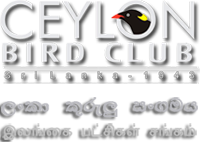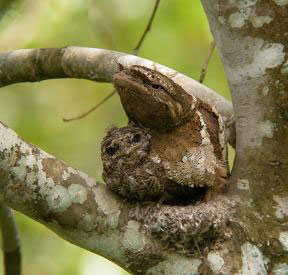


Kithsiri Gunawardena - CBCN February 2008 page 38 to 41
 A nest of the Ceylon Frogmouth Batrachostomus moniliger was found at Ratambalakota, Paragoda, Bulatsinhala, near Molkawa on 22 January 2008. Thushara Senanayake - whose interest in watching and studying birds is second to none I know - telephoned me from the site and informed me of his discovery.
A nest of the Ceylon Frogmouth Batrachostomus moniliger was found at Ratambalakota, Paragoda, Bulatsinhala, near Molkawa on 22 January 2008. Thushara Senanayake - whose interest in watching and studying birds is second to none I know - telephoned me from the site and informed me of his discovery.
He said he had visited a Rubber estate owned by a friend, and climbed a hillock in it, which is mostly planted, but with some light forest growth among the rubber. At a steep place he held to a tree for sup-port, climbed a few steps more, stopped to examine the surroundings, and suddenly noticed on a fork of the tree a small, unusual lump. It was only c. 2.5 m from where he stood and at nearly eye level. A closer examination revealed that it was the nest of a frogmouth containing a motionless chick with its back towards him. The adult was not in the nest, and he suspected that it flew away when he held the tree. In photographs taken by him that day the chick is covered in down, and resembles the exterior of the nest.
As I was unable to visit the site immediately we planned to do so during the weekend. On the 26th we arrived at the estate and climbed a steep footpath to reach the nest. This was built c. 3 m from the ground at the main fork of a Bombu Symplocos cochinchinensis tree, which was surrounded by Rubber Hevea brasiliensis and a few other Bombu, on a slope partially covered in Kekilla Dicranopteris linearis fern. The altitude here is c. 138 m. We positioned ourselves at an observation point c. 30 m from the nest to ensure there would be no disturbance to the birds and thus to observe their natural behaviour.
A greyish-brown adult male was seated in the nest, with only the rear part of the chick exposed and the rest of its body covered with the parent's breast feathers. The nest, a small circular pad, whose interior is known to be very soft, is made of the birds' own down feathers. The exterior had the characteristic pieces of lichen and small pieces of bark attached making detection quite difficult. The nest, chick and particularly the lichen-like white patches on the adult male blended so well with the bark of the tree and its lichen that the camouflage was perfect.
Soon, I observed that the bird closed its eyes and compressed its body while slowly stretching upwards at an angle of c. 45° with the bill and the rictal bristles pointing up. This gave it the appearance of a
broken-off branch of the tree. I had recorded similar behaviour in a male frogmouth on a nest at Sinharaja in April 1999 upon seeing an eagle circling in the sky above the nest. Just as I expected, I now found a threat from a raptor, a pair of Crested Honey-Buzzards Pernis ptilorhynchus circling above.
In this stage the chick had feathers all over its body - unlike the down 4 days ago - and horizontal barring on the face and breast area. The rest of the body was covered in light-rufous feathers. A few down feathers were still visible in the breast area. The rictal bristles had not developed as yet to any noticeable length. The tail was c. 4 cm long. The iris of the chick was yellowish grey, unlike the light yellow of the adults; and the dark pupil could be discerned by us.
During our observations both adult and nestling remained motionless for c. 30 to 40 minutes. Every 1 hour or so the chick would turn from side to side, open its mouth and change its sitting position, giving me good opportunities for digiscope photography.
We had the fortune to witness and photograph an interesting aspect of the threat behaviour of this species. An Indian Palm Squirrel Funambulus palmarum began to move along the branch in the direction of the nest. The male frogmouth took on a perfect camouflage pose by com-pressing its body to look like a broken-off branch. When the squirrel was c. 1 m from the nest the adult bird adjusted itself so that the chick was almost entirely covered. As the squirrel approached closer and closer the frogmouth started to puff up its throat and body little by little. When the intruder was c. 15 cm from the nest the frogmouth was so puffed up it looked almost like a ball. Then suddenly it opened its mouth and eyes quite wide. The squirrel, which was busy nibbling on the bark of the branch, all at once turned around and made a hasty retreat, possibly at the shock of the sudden sight of this elaborate threat display.
We observed the nest of these extraordinary birds from c. 10 a.m to 2 p.m, and left with the intention of returning a few days later to record the progress of the chick. The caretaker of the estate was instructed not to disclose the existence of the nest to anyone, to ensure its safety.
On the 31st we visited the nest again with CBC members Deepal Wara-kagoda and Niran Caldera, and reached the nest site c. 2.30 p.m. The male was observed seated in the nest. The chick had grown noticeably larger than on the previous occasion, with the tail c. 7 cm long. At c. 6.45 p.m the male made a call and left the nest. After a few minutes it came back with some prey to feed the begging chick. The chick flapped
its wings and moved away from the nest to the smaller branches of the tree. On one occasion it flew a short distance to alight on a branch further away which was covered in foliage. We left the site c. 7.15 p.m.
I learnt from Senanayake and member Namal Kamalgoda that they visited the site the very next day, 1st February, found that the birds had left the nest, and it was lying at the foot of the tree. On three prior occasions the nest of the species has been found on the ground beneath the tree it was built on after it was used. The first instance had been recorded by Warakagoda. A nest of this species stated to have been found thus was seen by me in the Western Ghats, India. Thandula Jaya-rathna, during the study described below, had observed the male actively removing the nest and letting it drop after the chick had left it. The exact reason for this behaviour is yet to be established.
Studies by W W A Phillips at the first two nests of the species to be discovered, and by Warakagoda at the next two several decades later, showed that the single egg is incubated in the daytime by the male. Observations by Lester Perera, Upali Ekanayake and Kasun Ekanayake revealed that the young bird is brooded by the male during the day, and that at night this duty is shared by the female. A lengthy study at a nest by Jayarathna provided further evidence of these facts, and established that at night both parents incubate the egg, and brood and feed the nestling.
The sexual dichromatism of this species, which had never been worked out correctly, was studied and explained by Warakagoda, by analyzing field records, photographs and illustrations by others and his own obser-vations. He ascertained that females are always rufous with a few small white to grey spots on the underparts and occasionally upperparts, and males vary from dark greyish-brown to rufous-brown with large whitish to grey patches on the scapulars, tertials and upper tail.
To date, many nests with greyish-brown males and one with a rufous-brown male have been recorded. The bark on the supporting tree near the former was always greyish, and near the latter was brown. In all but one instance it was mottled with lichen. The ability of these birds to choose nesting sites on trees which match the male in colour and are suitably covered in lichen is quite striking.
While observing the present nest a connection between the behaviour of the species and the plumage difference of the sexes became evident. The coloration provides camouflage during the time of day each sex engages in its duties at the nest. In daylight the male blends with the
surroundings as described above, but the plainer, rufous female would be conspicuous, while at night her coloration would matter less.
I was very happy that the nestling had been reared successfully, and that we had actually watched its maiden flight the previous day.
Acknowledgements
I am very grateful to Dr Thushara Senanayake for informing me of the nest and accompanying me to the site on both occasions above. I thank Mr J P Gunadasa, the caretaker of the estate, for his hospitality, and for taking due measures to protect the nest. I wish to express my gratitude to my friend Mr Deepal Warakagoda, the authority whom I consult on all aspects of the ornithology of Sri Lanka, for sharing his knowledge on the behaviour and morphology of the present species.
References
Ekanayake U & Ekanayake K. 2002. In: Ceylon Bird Club Notes. February.
Henry G M. 1998. A Guide to the Birds of Sri Lanka. 3rd edn. KVG de Silva and Sons & Oxford University Press.
Jayarathna K D T. 2004. Observations on a nest of Sri Lanka Frogmouth Batrachostomus moniliger. Forktail. No.20.
Legge W V. 1880. A History of the Birds of Ceylon. 1983, 2nd edn. Tisara Prakasakayo.
Perera L & Ekanayake U. 2002. In: Ceylon Bird Club Notes. February.
Perera L. 2002. Observations of a nestling of the Ceylon Frogmouth Batrachostomus moniliger. Ceylon Bird Club Notes. May.
Phillips W W A. 1941. Ornithological observations. Part III. Loris. 2(5).
Phillips W W A. 1979. Nests and Eggs of Ceylon Birds XI. Trogoniformes, Apodiformes & Caprimulgiformes. Ceylon Journal of
Science (Biological Sciences). Vol.13, nos.1,2.
Rasmussen P C & Anderton J C. 2005. Birds of South Asia: the Ripley Guide. Vols.1,2. Smithsonian Institution & Lynx Edicions.
Senanayake T. 2008. Personal communication.
Warakagoda D. 1999. In: Ceylon Bird Club Notes. April.
Warakagoda D. 2001. Colour variation and identification of the male Cey-lon Frogmouth Batrachostomus moniliger, and its daytime incubation. Ceylon Bird Club Notes. June.